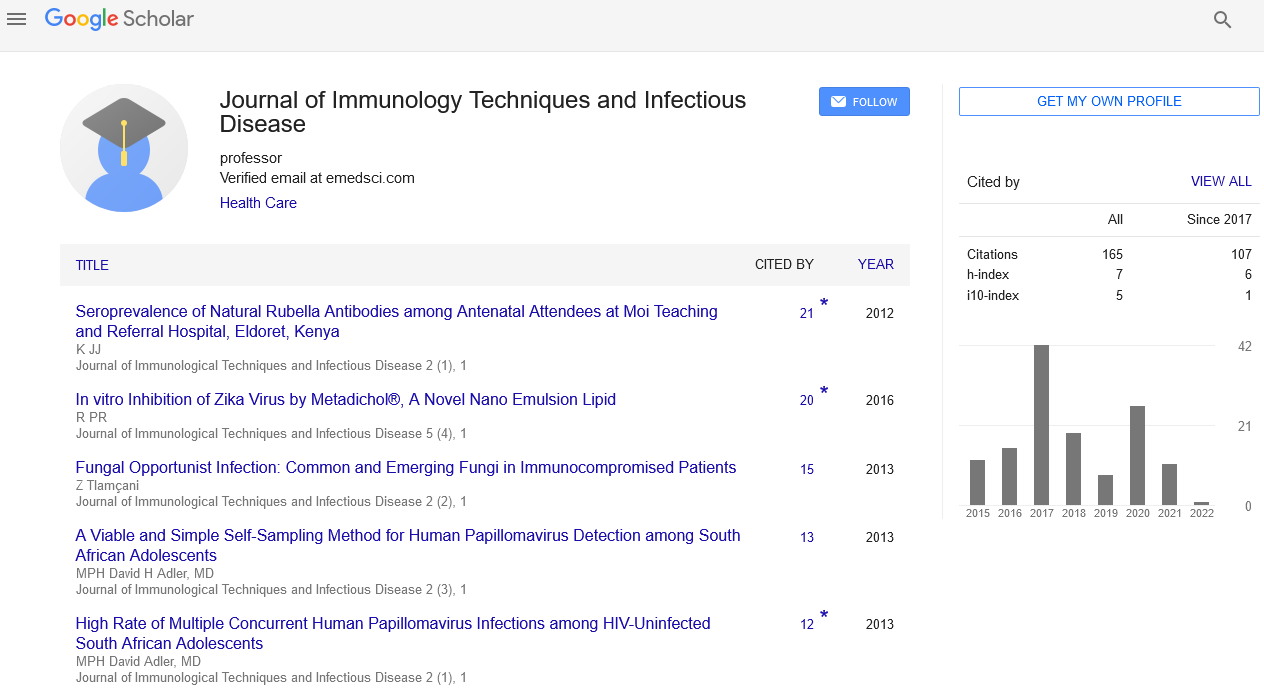Opinion Article, J Immunol Tech Infect Dis Vol: 12 Issue: 3
Understanding the Severity of Ebola Infection: Causes, Symptoms, and Impact
Denile Schwin*
1Department of Pathology and Immunology, Washington University, Washington, USA
*Corresponding Author:Denile Schwin,
Department of Pathology and
Immunology, Washington University, Washington, USA
E-mail: denileschwin092@gmail.com
Received date: 30 August, 2023, Manuscript No. JIDIT-23-116441;
Editor assigned date: 01 September, 2023, PreQC No. JIDIT-23-116441 (PQ);
Reviewed date: 15 September, 2023, QC No. JIDIT-23-116441;
Revised date: 22 September, 2023, Manuscript No. JIDIT-23-116441 (R);
Published date: 29 September, 2023, DOI: 10.4172/2329-9541.1000353.
Citation: Schwin D (2023) Understanding the Severity of Ebola Infection: Causes, Symptoms and Impact. J Immunol Tech Infect Dis 12:3.
Description
Ebola Virus Disease (EVD), often referred to as Ebola, is a highly contagious and severe illness caused by the Ebola virus. This viral infection has gained global attention due to its devastating outbreaks in Africa and the potential for rapid spread the severity of Ebola infection, examining its causes, symptoms, and the impact it has on individuals and communities. The Ebola virus primarily infects humans and non-human primates. It is believed to be transmitted to humans from wild animals and subsequently spreads within human populations through human-to-human transmission. The exact reservoir host of Ebola is not definitively known, but fruit bats are considered a possible source of the virus.
Direct contact with blood or body fluids
People can become infected through contact with the blood, secretions, organs, or other bodily fluids of infected humans or animals. This can occur during caregiving, traditional burial practices, or through medical procedures without appropriate protective measures. Ebola can also be transmitted through contact with surfaces and materials contaminated with the virus, such as needles and syringes used on infected patients. In some parts of Africa, the virus has been transmitted to humans through the consumption of infected wild animals, especially bats and non-human primates.
Symptoms of Ebola Infection
The severity of Ebola infection becomes evident through a range of symptoms that typically manifest within 2 to 21 days after exposure to the virus. The initial symptoms are often nonspecific and resemble those of other common illnesses, making early diagnosis challenging. However, as the disease progresses, the symptoms become more severe.
The sudden onset of a high fever is often the first sign of Ebola infection. Patients often experience extreme weakness and fatigue. Severe muscle and joint pain can be debilitating. Intense headaches are a common symptom. Patients may develop a sore throat and difficulty swallowing. Nausea, vomiting, and diarrhea are frequent symptoms, which can lead to dehydration. Ebola can cause liver and kidney impairment, leading to organ failure. Some patients may develop a characteristic rash. In severe cases, bleeding can occur from various parts of the body, both internally and externally. As the disease progresses, patients may go into shock and experience multiple organ failure, which often leads to death.
Impact of Ebola infection
One of the most alarming aspects of Ebola is its high mortality rate. Depending on the strain and the quality of medical care available, Ebola outbreaks have reported case fatality rates ranging from 25% to 90%. Ebola outbreaks can overwhelm healthcare systems in affected areas. The limited availability of resources, trained medical staff, and treatment facilities can result in inadequate care and the further spread of the virus. Beyond the immediate health impact, Ebola has significant social and economic consequences. Communities affected by Ebola often face stigma, disrupted livelihoods, and strained social networks. Ebola outbreaks can lead to fear and panic, causing people to avoid healthcare facilities and engage in unsafe practices that contribute to the spread of the virus. Due to the potential for international spread, Ebola outbreaks often trigger global concern and coordinated response efforts by international organizations, governments, and humanitarian agencies.
Conclusion
Ebola infection is a grave and severe illness with a high potential for morbidity and mortality. Its causes, symptoms, and impact extend beyond the immediate health implications to encompass social, economic, and international concerns. Timely diagnosis, isolation, and treatment, along with stringent infection control measures, are essential in containing and mitigating the severity of Ebola outbreaks. Global collaboration and investment in healthcare infrastructure in affected regions are dangerous to reducing the impact of future outbreaks and preventing the spread of this deadly virus.
 Spanish
Spanish  Chinese
Chinese  Russian
Russian  German
German  French
French  Japanese
Japanese  Portuguese
Portuguese  Hindi
Hindi 
